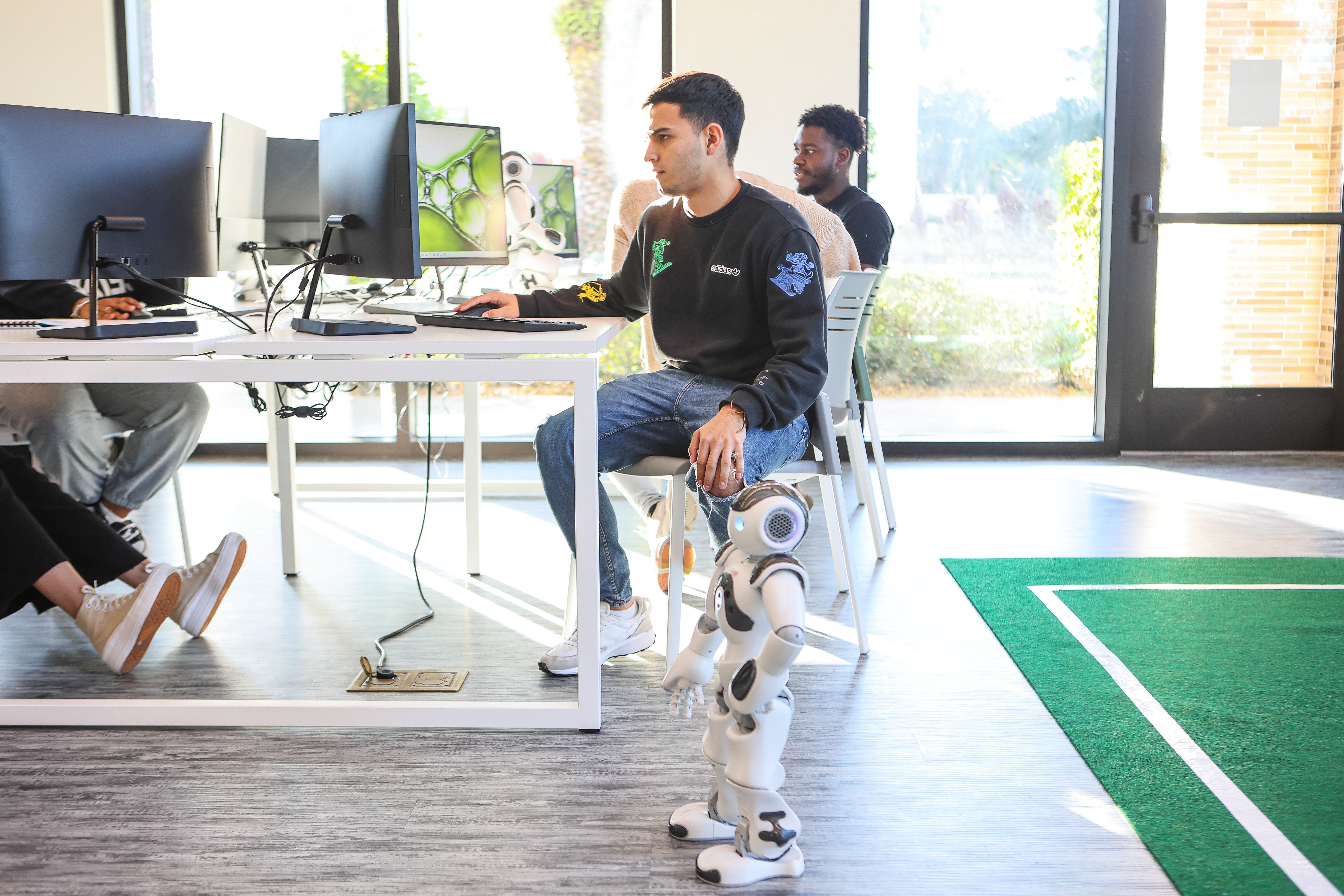By Katie Brenneman
 Saint Leo University- AI Lab implementation by RobotLAB
Saint Leo University- AI Lab implementation by RobotLAB
Once upon a time, robotics and artificial intelligence (AI) systems were largely the stuff of science fiction. If they appeared in “real life,” it was primarily in the most advanced, technology-driven enterprises, those to which most ordinary working people had little, if any, connection.
Today, however, the situation has dramatically changed. Robotics and AI are now infiltrating almost every aspect of daily life. They’re shaping how we communicate and learn. They’re transforming the practice of medicine. And they’re even informing how we accomplish the most mundane of daily tasks from banking to shopping to cleaning the house.
But perhaps nowhere is the influence of these technologies more important or apparent than in the world of work. No matter what the particular industry, robotics and AI are proving increasingly critical to the success of business enterprises and workers alike.
That means that it is incumbent upon educators to prioritize technology in their curricula in order to prepare students for the implementation of robotics and AI in the workforce. This article examines the importance of technology training in elementary, intermediate, and secondary schools. It also describes strategies educators can use to infuse science, technology, engineering, and mathematics (STEM) into their classroom practices.
Robotics, AI, and the Future of Work
As intimidating and mysterious as robotics and AI can sometimes feel to laypersons, the reality is that these technologies are ubiquitous in daily life. And what is true of the world outside the workplace is equally true inside the office — perhaps even more so.
Robotics and AI are shaping work processes in almost every industry from careers in government to retail to finance to manufacturing. Now more than ever, these technologies are being used to streamline workflow, enhance security, optimize risk management, and facilitate decision-making.
And what this means is that students don’t have to have their minds set on a tech career to benefit from a robust robotics and AI education. But it’s not only in preparing students to use the tools and processes of the modern workplace that the advantages of robotics and AI training lie.
In addition to the myriad of hard skills in STEM that such education provides, robotics and AI also teach children essential soft skills, those required to succeed in every workplace. These include effective communication, creative problem-solving, critical thinking, and productive collaboration.
Robotics, AI, and Workplace Safety
For all the vast benefits of technology in improving workflow, driving productivity, and supporting efficiency, it’s the technology’s capacity to enhance safety that matters most. Robotics systems, for example, are increasingly being used to protect workers and stakeholders by automating dangerous tasks.
For instance, robots may be used to enter collapsed and unstable buildings in search and rescue operations. They may operate in sites where toxic chemicals have been released. They may perform a wide range of hazardous operations, from defusing explosives to repairing bridges and high-rises.
They’re also increasingly used in medical education and practice to significantly increase patient safety. Robotics, for example, are being used to train medical students to perform delicate procedures and surgeries. They’re also being used by practicing surgeons in microsurgery and for procedures and operations in areas of the body that the surgeon simply cannot access safely.
Similarly, AI systems are now prevalent across an array of medical domains. AI systems are now ubiquitous for assessing medical images, increasing the speed and accuracy of diagnosis, and facilitating evidence-based treatment planning.
Robotics, AI, and Security
In addition to optimizing safety, robotics and AI are also proving critical to workplace security, including supporting cybersecurity in remote and hybrid teams. For instance, AI systems can be used to provide continuous monitoring of work processes and systems, immediately alerting stakeholders when suspicious activity is found.
They can also evaluate the security status of connected devices, including those in use by remote workers. These systems can enforce cybersecurity best practices through automated alerts and even denial of service triggers for workers not connected to a virtual private network (VPN), firewall, or secure password.
Robotics may also be used to provide an additional layer of security for both the physical campus and for remote workers and stakeholders connected to the enterprise network. For instance, biometric scanners, from fingerprint readers to retinal scanners, can be used to secure work devices, no matter where they may be physically located. This ensures that a stolen or lost device does not pose a significant cybersecurity threat.
The Takeaway
Educating school children in robotics and AI is far more than an effective way to teach often esoteric STEM topics. Now, more than ever, it’s a critical step in preparing children for the future of work. Robotics and AI play a vital role in the modern workplace, regardless of the particular industry. They’re being used to streamline workflows and bolster efficiency and productivity, while at the same time maximizing safety and security both on and off the job site.
Want to learn more about Robotics and AI?
Check our K-12 and Higher Education catalogs to learn more
Author: Katie Brenneman is a passionate writer specializing in lifestyle, mental health, tech education, and fitness-related content. When she isn't writing, you can find her with her nose buried in a book or hiking with her dog, Charlie. To connect with Katie, you can follow her on Twitter.


